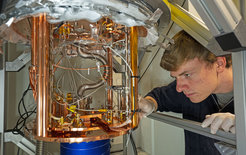
The path to a quantum network: erbium dopants stimulated to emit single photons
Erbium atoms in silicon can be used to build quantum networks. Researchers at the Max Planck Institute of Quantum Optics have now succeeded in taking an important step in this direction.
Researchers at MPQ in Garching, together with a team from TU Munich, have excited erbium atoms embedded in crystalline silicon such that they emit single photons. Their special properties can form the basis for the development of extended networks that link quantum systems with each other, all the way to a future quantum internet. This would allow for information to be exchanged via fibre-optic networks with provable privacy and security. The novel system used by the researchers offers key advantages in the production of network nodes, their cooling and the range of data transmission.
The controlled use of quantum physical phenomena such as the entanglement of several particles enables completely new technical applications – for example, the construction of highly sensitive quantum sensors and fast quantum computers. With these, certain tasks that are unsolvable for conventional computing machines can be accomplished in a short time. These and other quantum technologies could operate very effectively in quantum networks in the future. A promising platform for their realisation has now been demonstrated by a team of researchers at the Max Planck Institute of Quantum Optics (MPQ) and the Technical University of Munich (TUM) in Garching.
"All quantum technologies are based on so-called qubits, the elementary carriers of quantum information," explains team leader Prof. Dr. Andreas Reiserer. If they are connected with each other by light, a quantum network can be created, similar to what is done today in the "classical" internet. The qubits can be individual atoms that are isolated from each other and embedded in a solid host material. This works particularly well with erbium atoms in a silicon crystal, as Reiserer and his team recently showed. Now the researchers made another important step forward: they excited individual erbium atoms in such a way that they subsequently emitted individual photons – with properties that are ideal for the construction of quantum networks.
Ideal conditions for telecommunications
For this purpose, Reiserer's research team implanted – in technical jargon: doped – the atoms of the rare earth metal into the silicon crystal lattice at specific positions. "This gives the erbium atoms excellent optical properties," explains the physicist: they emit light with a wavelength of 1536 nanometres. This is almost identical to the light wavelength used for data transmission in fibre optic networks for classical telecommunications – because it is characterised by comparatively low loss. "This allows for quantum information to be transmitted over long distances," adds Reiserer.

“However, in order to make technical use of these fundamental properties of erbium, one has to stimulate the atoms to emit individual light particles in a controlled manner," says Andreas Gritsch, a doctoral researcher in Andreas Reiserer's team at the MPQ. "In this way, an interface for sending or receiving quantum information can be created." Now, the researchers in Garching and Munich have succeeded in doing just that. They used an optical resonator – a device that can reflect light and thereby amplify it – for this purpose. "For the first time, we have produced a resonator made of silicon doped with erbium," reports Gritsch.
A light amplifier in nano format
However, this resonator did not consist of mirrors like most optical resonators, but of a specific structure of crystalline silicon: regularly arranged holes in the material that are only a few nanometres (millionths of a millimetre) small. The entire unit measured only a few micrometres and contained only a few dozen erbium atoms. The researchers coupled it to an optical fibre that allowed laser light to enter the so-called nanophotonic resonator to excite the atoms. "In this way, we were able to accomplish the emission of individual photons with the desired characteristics", explains Andreas Gritsch.

The physicist and his team have thus created a possibility to specifically generate qubits for the transport of quantum information. And: "The fact that this is possible in crystalline silicon offers an additional opportunity for the realisation of quantum networks," says Reiserer, "because this material has been used for decades to produce classic semiconductor elements, for example microchips for computers, smartphones or navigation devices." The required manufacturing techniques and processes are technically mature and established in the semiconductor industry. "This means that for quantum technology applications, such as the construction of quantum networks, silicon crystals can also be produced in high quality and purity," emphasises Reiserer – and quite cheaply, too.
There is also another advantage of the system developed by the MPQ and TUM scientists: the excellent optical properties of the erbium atoms embedded in silicon appear – thanks to a special type of preparation – not only at absolute zero temperature at minus 273 degrees Celsius, but also at up to eight degrees above this temperature mark. "And these few degrees make a big difference in practice," explains Reiserer: "Because such temperatures are technologically easy to achieve by cooling in a cryostat with liquid helium." This helps to pave the way towards technical applications.
Totally tap-proof
These could be of great interest e.g. to financial institutions, medical facilities or government agencies, where sensitive personal data or classified information is handled. While today even the best encryption cannot guarantee complete security, a quantum network would offer perfect data protection: as soon as an eavesdropper tried to intercept the information transmitted by prepared photons, their quantum properties would be lost and the data would become unusable.
(Image caption at the top: A single dopant in a nanophotonic silicon chip is used to generate photons at a wavelength that is compatible with existing optical fiber infrastructure. Image by C. Hohmann, MCQST.)













